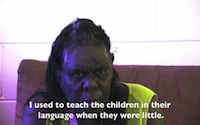Western Arnhem Land Rock Paintings
The languages being recorded by our project team are spoken by Aboriginal people of Australia. Physically, culturally and linguistically the people of the Croker Region are related to other Aboriginal groups, though with many region-specific characteristics. Archaeological excavations in the Kakadu region not far to the south have established an early presence there, from at least 40,000 years ago, with some researchers claiming an antiquity of more than 55,000 years. There has been continuous Aboriginal occupation of the region over this long period, despite a fluctuating sea level and associated changes to the environment.
Origin myths of the region state that Warramurrungunji, the founding ancestress, came out of the sea just north of Croker Island, having travelled from Indonesia. She proceeded inland, giving birth and populating the country as she went. She established the many different language groups ‘so people who would know who they were’, and planted the countryside with edible yams and lilies.
Mud Crabs
The peoples of the region traditionally lived as hunters, gatherers, and fishers, drawing on the sea for most of their protein, through fish, turtle, dugong and shellfish. Traditional hunting techniques employed spears, nets and bark canoes, and were focussed on the areas close to shore, with some excursions to reefs and outlying islands. The land mostly supplied plant foods (wild yams and other roots, water lilies, various wild fruits) though also, in season, birds like magpie geese, as well as a wide range of other game.
Ritual associated with funeral ceremony
In the seventeenth or eighteenth centuries, contact began with the Macassans, who visited the Cobourg area from Makassar in Sulawesi, Indonesia in search of trepang (bêche de mer), turtle shell and sandalwood. Various technological innovations such as dugout canoes, detachable harpoons and metal blades date from this period. This increased the range of people’s marine activities and made it easier to reach the more outlying islands. Many indigenous people of the region worked for the Macassans and visited Makassar, some even staying on there. Despite these technological changes, however, the basic mode of subsistence did not change.
Port Essington ca. 1870′s
Between 1827 and 1849 the British attempted to found a northern settlement on Cobourg Peninsula, most notably at Port Essington, in the hope of establishing an ‘Australian Singapore’, but these efforts proved futile and were soon abandoned. It has only really been since the 1930s that the European presence in the region has really been felt, through the founding of a ‘half-caste mission’ on Croker Island, which led to the removal of most of the island’s traditional owners; the construction of a lighthouse at Cape Don on the western tip of the peninsula; and the establishment of timber and pearling industries in the area.
Social Organization
As is the case in all Australian Aboriginal societies, each individual belongs to a patrilineal clan, which in turn is linked to particular clan lands and sea territories, generally known as clan estates. Clan membership is transmitted from father to child, though individuals also have secondary rights in their mothers’ and grandparents’ clans. Though it is possible to hunt, gather and fish in the country of other clans, permission has to be sought first from senior clan members.
A language is traditionally associated with one or more clans, and appropriate etiquette is to speak it when on the country of those clans. Children grew up speaking their clan language, but since one always married out of the clan, the norm was for each parent to speak a different language, and for children to move between residence in a number of clan estates while growing up. This resulted in children growing up with an exposure to several languages – their father’s, their mother’s, and those of their grandparents.
Though it was normal to grow up multilingual, this did not entail equal fluency in all languages, and it could happen that the language one spoke most fluently, as a result of residence, did not coincide with one’s ‘official’ clan language. The recent cultural changes flowing from European contact mean that alignments between language and clan often become blurred.
The fabric of traditional society encourages a network of contacts and interdependencies between the various clans. This network is reflected in the staging of ceremonies, e.g. funerals or initiations, that require the cooperation of members of distant clans, as songmen or as ceremonial bosses; the tracks of ancestral figures which criss-cross and link together the clan estates; and the exchange of personal names between clans.
Skin Diagram
Most importantly, a system of ‘skins’, or subsections, divides the whole social universe into eight categories which track descent through the female line. This system sums up the kin relations between any two individuals, regulates possible marriage partners, and serves as a ready reckoner by which two strangers can calculate their kin relationship to each other.
The system appears to have been introduced from the south and east within the last 200 years and was superimposed on an older system, remnants of which still exist. The skin names are shared with other languages across a vast area of the continent, from the Indian Ocean in the west, to the Gulf of Carpentaria in the East, and as far south as Alice Springs. In principle, the system can be used to calculate social relations over that whole region.
Iwaidja Speakers Today
Ilijili’s Verandah
The largest concentration of speakers of Iwaidja is now found at Minjilang, on Croker Island, with smaller family groups based at various ‘outstations’ on traditional clan territories. The community of Minjilang was established in the early 1970’s after the abandonment of the Methodist Mission and is now home to around 260 inhabitants.
People’s lives in the region today combine traditional and modern elements. On Croker Island one finds modern houses, a school, offices, workshops, a store and a clinic. Televisions and phones have been integrated into everyday life, but at the same time many fundamental elements of pre-contact culture remain – funerals and ceremonies with their rich accompaniments of music and dance, the pursuit and procurement of bush foods, and the fundamental role of kinship, clan and spiritual and social ties to country.
Although most people of the region see no contradiction between holding onto key aspects of traditional culture and living in the modern world, they are also keenly aware that the younger generation is slipping away into the realm of rap, discos and city life just an hour’s plane ride away in Darwin. Language is interwoven with all of the traditional pursuits outlined above, and the DoBeS Iwadja Documentation Project is seen by the community as facilitating a need to keep alive traditional knowledge of the country, its resources, and its spiritual connections.




